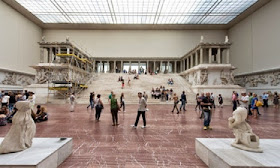 |
| The Altar of Pergamon [Credit: DPA] |
The ancient city of Pergamon rose to greatness after receiving a huge sum of money as war expenditures, and became the most eminent centre of culture of the Hellenistic period for 150 years. One of its rulers, Eumenes II (197-159 BC), took the acropolis of Athens as an example and had the acropolis of Pergamon adorned with works of art, after which Pergamon became one of the most graceful cities of the world.
One of the most famous buildings that once stood on the property is the Altar of Zeus and Athena, which used to be located to the south of the theatre. Eumenes II constructed it as a memorial of the victory against the Galatians. The Altar has the shape of a horseshoe and its dimensions are 36.44 by 34.20 meters. The high reliefs on the outsides of the altar depict the Gigantomachy. At Pergamon, nothing remains of the altar but its foundations; the rest was removed from the site and shipped to Berlin.
Almost 1.5 million people visited the Pergamon last year, making it Berlin’s most popular museum. The altar was restored between 1994 and 2004 and is in reasonable condition, unlike the rest of the museum, Scholl said. Although some work will be carried out on the altar, the state of the museum building is the main reason for the five-year closure of the hall. The director of the museum’s antiquity collection, Andreas Scholl commented:
“Much of the building is in a horrible condition. Steel has rusted, glass is in a bad way, the electrics date back to 1929, so you can imagine what they’re like. There’s no climate control, all the water and power systems need to be redone.”
With the shutting of the Pergamon Hall, and the wing housing Greek antiquities already closed, just one section of Germany’s most famous museum will remain open--the wing housing the Babylon or Ishtar Gate (Ischtar-Tor) and the Market Gate of Miletus (Markttor). Scholl told The Local that the museum has braced for fewer visitors after Sunday, particularly as its capacity would be reduced.
A total of €385 million will be spent on the Pergamon under a master plan for the entire Unesco World Heritage Site area known as Museum Island. Under the master plan a fourth wing will also be built on the Pergamon. It will become the main entrance and house an Egyptian collection.
No comments:
Post a Comment